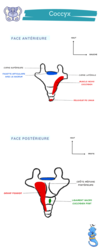Coccyx pain and osteopathy
What is coccygodynia?
Coccygodynia is a term used to describe pain in the area of the coccyx (tailbone), which is the bone at the base of the spine. This pain can be caused by a variety of things, such as injury or irritation to the bone or surrounding muscles, or inflammation of the skin or soft tissue in this area.
Coccygodynia can be very uncomfortable and can lead to difficulty sitting or standing.
If you are suffering from tailbone pain, it is important to consult a doctor to determine the cause of the pain and receive appropriate treatment.
What is the coccyx?
The coccyx is a bone located at the base of the spine, at the tip of the sacrum. This bone is formed by the fusion of several embryonic vertebrae, and it plays a role in the stability of the lumbar and pelvic region.
The coccyx is small but it can be the source of very disabling pain in certain situations.
The anatomy of the coccyx


Clinic / symptoms of coccygodynia
Pain in the coccyx and/or sacro-coccygeal joint (between the sacrum and the coccyx).
The pain may radiate forward or even sciatica-like
Causes of coccyx pain
The causes of coccygeal pain can be many and varied. Here are some examples of possible causes of coccyx pain:
- Trauma (60-70% of cases): fracture or dislocation, even old ones. If you fall on your buttocks or bump into something hard, this can cause severe pain in this area.
- Irritation or inflammation of the surrounding muscles and tissues: If the muscles and tissues around the tailbone are irritated or inflamed, it can cause chronic pain in this area.
- Inflammation of the skin or soft tissue: In some cases, the skin or soft tissue around the tailbone may become inflamed, which can cause pain in that area.
- Posture problems: if you have improper posture habits, this can lead to excessive pressure on the tailbone, which can cause pain in this area.
- Digestive disorders: some digestive disorders, such as chronic constipation or irritable bowel syndrome, can cause pain in the coccyx area.
- Prostate problems: In men, certain prostate problems can cause pain in the coccyx area.
- Gynaecological disorders: endometriosis can, for example, cause pain in the coccyx depending on its location.
- Pregnancy especially in the 3rd trimester
- Post partum (after the birth)
This list is not exhaustive...
Treatment of coccygodynia
Treatment for coccygodynia depends on the underlying cause of the tailbone pain. Here are some examples of treatments that can be used to relieve pain in this area:
- Painkillers: If tailbone pain is acute, painkillers such as paracetamol can be used to relieve the pain.
- Anti-inflammatory drugs: If tailbone pain is caused by inflammation, anti-inflammatory drugs can be used to reduce inflammation and relieve pain.
- Medication for constipation: If tailbone pain is caused by constipation, laxatives or medications to improve bowel motility can be used to relieve the pain.
- Relaxation techniques: Relaxation techniques such as deep breathing or progressive muscle relaxation may be helpful in relieving tailbone pain by reducing the level of tension in the muscles and surrounding tissues.
- Strengthening exercises: Strengthening the pelvic and perineal muscles and the lumbar region can be helpful in improving pelvic stability and reducing pressure on the tailbone.
- Osteopathy +++
This list is not exhaustive...
How can osteopathy help coccyx pain?
The management of tailbone pain is obviously dependent on the cause.
Osteopathy can be an effective approach to relieving tailbone pain. The osteopath will examine the lumbar and pelvic region to determine the possible causes of the pain and adapt his or her treatment accordingly.
In some cases, osteopathy will have to wait, it is for example the case of fractures of the coccyx where it will be necessary to wait approximately 3 months before the osteopath can work.
He or she may use different manipulative techniques to relieve muscle and ligament tension, etc. To do this, your osteopath will only use external techniques and not internal ones.
Osteopathy aims to restore the balance and mobility of the different structures of the body to allow it to function optimally. Thus, by treating the lumbar and pelvic region, the osteopath can help relieve coccyx pain by acting on the different elements that can be the cause of this pain.
Marie Messager
Osteopath D.O
2 rue Alexis de Tocqueville
78000 Versailles

